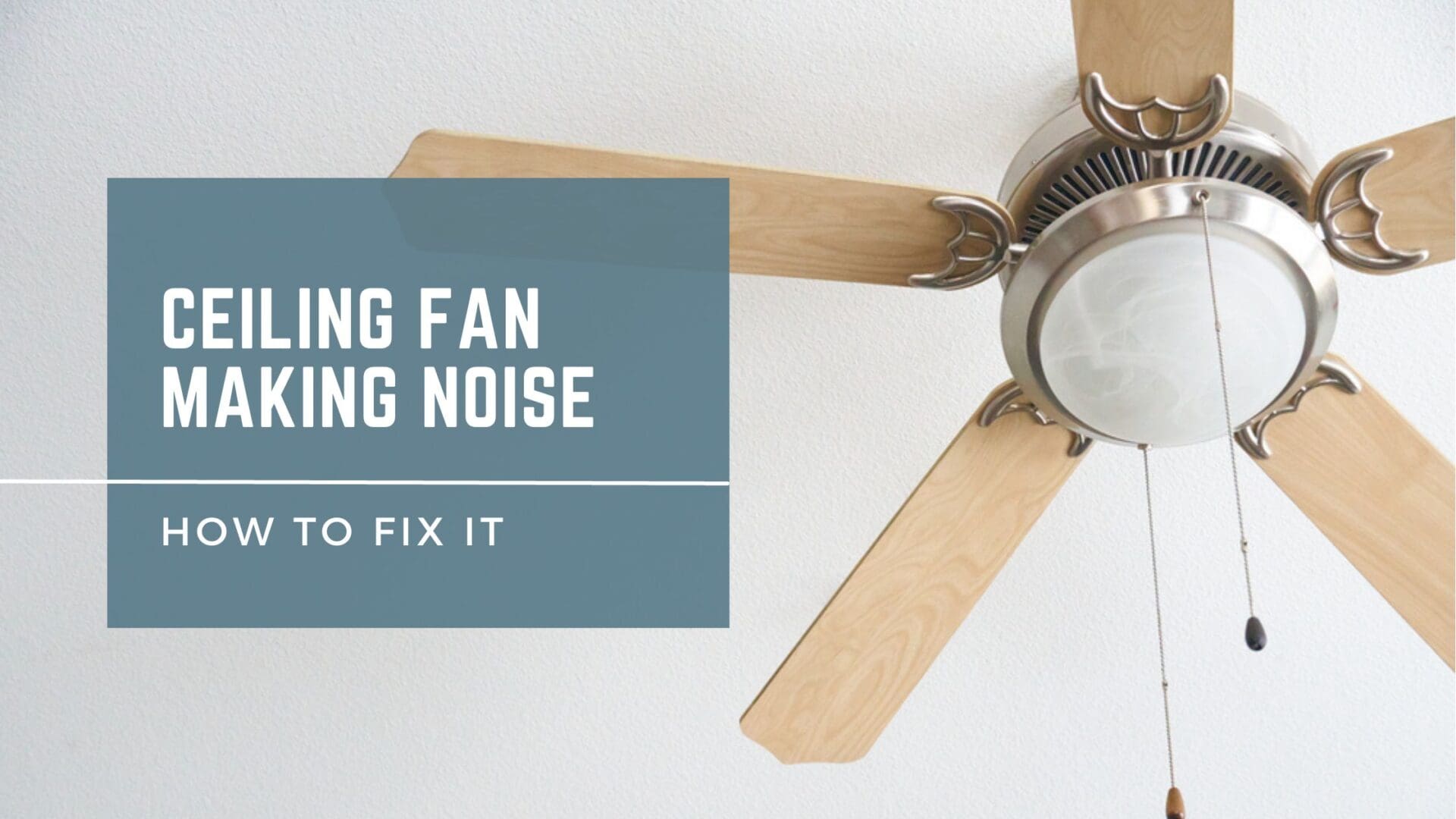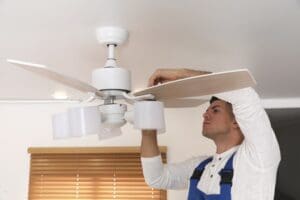
A noisy ceiling fan can disrupt the tranquility of any space, turning what should be a comfortable and relaxing environment into a constant source of irritation. Addressing these strange fan sounds is essential not only to preserve your peace of mind but also to ensure the safe functioning and longevity of the fan itself.
Ignoring the loud fan noise can lead to more severe complications or damage over time. So why is my ceiling fan making noise? If you’re experiencing issues with your ceiling fan making noise, the experts are here for you. In this article, we’ll explore the common causes of ceiling fan noises and provide practical solutions to help you restore calm and comfort to your living space.
Types of Ceiling Fan Noise
Why is my ceiling fan making noise? The reason your ceiling fan makes noise will vary from simply being unbalanced to having electrical issues. The exact type of noise it makes can help you understand where the issue might be. Here are the three prominent noises you’ll likely experience.
Humming or Buzzing
If your ceiling fan hums or buzzes, it may indicate an underlying electrical issue. This fan noise is often more noticeable if the fan is connected to a dimmer switch. Potential causes of these ceiling fan huming sounds include wiring problems within the fan itself or a deteriorating motor.
It’s crucial to remember that electrical issues should always be handled by a licensed electrical service to ensure safety and proper electrical repairs. Don’t attempt to perform an electrical repair on your own. Instead, rely on a professional to diagnose and address the root cause of the ceiling fan humming or buzzing noise.
Clicking
If your ceiling fan is making a clicking noise, it can indicate that some of the blades are loose. It may also make a knocking sound. If your fan has a light kit attached, it could be another source of the clicking sound if it becomes loose over time.
Wobbling
You may observe a wobbly motion in the fan when the blades aren’t securely fastened. Fortunately, resolving this issue is relatively straightforward. Tighten the screws on the blades and the light kit, if applicable, to eliminate the wobbling and restore stability to your ceiling fan.
How to Fix the Ceiling Fan Noise

Let’s look at ways to fix your ceiling fan and stop it from making noise.
1. Do a Thorough Inspection
Doing an electrical inspection on your ceiling fan is essential in identifying and addressing any issues it may have. Begin by observing the fan both when it’s on and off. While the fan is operating, look for any signs of wobbling, which could indicate loose or imbalanced components.
When the fan is turned off, carefully examine the blades for dirt buildup or visible damage, like warping or cracks.
2. Tighten Any Loose Screws
Tightening screws is an effective way to stop the noise, as loose components can rattle. Ceiling fans have multiple screws that may become loose over time due to vibrations and regular use. Tighten the screws that secure the blades in place, ensuring they are firmly fastened.
If your ceiling fan contains a light kit attached, inspect and tighten the screws holding it in position as well. You can even try adding oil or pipe cleaner into the oil hole near the down rod. Check your owner’s manual to ensure you use the best oil for your fan.
3. Clean the Fan
Dirt buildup on your ceiling fan blades can contribute to an off-balance fan, leading to noise during operation. Cleaning the ceiling fan can help rectify this issue and improve its performance. By carefully cleaning all the blades, you can restore balance to your ceiling fan, ensuring smoother and quieter operation.
4. Try Out a Balancing Kit
If your ceiling fan continues to make noise even after cleaning and tightening screws, you may want to consider using a balancing kit to address any remaining imbalance issues. It can be an effective solution if you’re not sure how to balance a ceiling fan yourself.
A balancing kit typically includes a plastic clip and adhesive weights that can be applied to the blades to achieve optimal balance. Here’s how to identify troublesome fan blades using a balancing kit:
- Attach the plastic clip to the leading edge of one blade.
- Test the fan to observe if the wobbling has improved.
- Repeat this process for each blade until you identify the one causing the imbalance.
- Once located, use the adhesive weights provided in the kit to fine-tune the balance by placing them on the top or bottom side of the problematic blade.
Testing and adjusting as needed will help eliminate any remaining noise, ensuring your ceiling fan operates smoothly and quietly.
5. Get New Ceiling Fan Blades
Damaged blades can create an imbalance in your ceiling fan, leading to wobbling and noise during operation. Blades can become damaged due to warping, cracks, or other forms of wear and tear, impacting their ability to maintain a uniform balance. This imbalance generates noise and can also put undue stress on the fan’s motor, potentially shortening its lifespan.
To remedy this problem:
- Inspect the blades for any visible signs of damage.
- If you identify one or more damaged blades, consider replacing them with new ones compatible with your fan model.
- Replace all blades simultaneously, as mixing old and new blades can lead to further imbalances.
When to Contact a Professional

While some ceiling fan issues can be resolved through simple DIY solutions, there are cases where professional help is necessary to ensure safety and proper repairs. Here are some instances where a professional is needed.
Electrical Issues
If the fan’s noise is caused by an electrical problem, such as faulty wiring or a malfunctioning motor, it’s best to consult a licensed electrician. Handling electrical repairs without proper knowledge and experience can be hazardous.
Installation Errors
If the fan was improperly installed, leading to issues like wobbling or poor performance, a professional technician can assess and correct the installation. This will ensure optimal operation and safety.
Complex Repairs
Some fan issues may involve intricate repairs that require specialized tools or expertise, like ceiling fan motor replacement or addressing internal components. In these cases, seeking professional assistance is recommended.
Preventative Measures
A noisy ceiling fan isn’t always avoidable. However, you can perform some preventative measures to ensure your fan performs optimally.
Regular maintenance
Regular maintenance is crucial to avoid potential problems and ensure the optimal functioning of your ceiling fan. Implementing the following practices will help you keep your fan running smoothly and quietly:
- Regularly tighten screws and other components
- Clean fan blades and motor
- Lubricate bearings
- Inspect for wear and tear
- Balance blades:
By incorporating these maintenance practices into your routine, you’ll extend the life of your ceiling fan and enjoy a comfortable, quiet environment in your home.
Proper Installation
A proper ceiling fan installation is crucial in ensuring the fan’s safety, efficiency, and longevity. When installed correctly, a ceiling fan provides optimal air circulation, contributes to energy savings, and operates quietly. Conversely, improper installation can lead to issues like wobbling, loud noises, or potential hazards due to loose components or electrical problems.
Additionally, an incorrectly installed fan may put undue stress on the motor, shortening its lifespan and resulting in costly repairs or replacement.
By ensuring your ceiling fan is installed properly from the start—either by following manufacturer guidelines or hiring a professional ceiling fan repair technician—you’ll enjoy a comfortable, safe, and efficient living environment while maximizing the performance and durability of your fan.
Tips for Keeping Your Fan Running Quietly
To keep your ceiling fan running quietly and efficiently, follow these helpful tips:
- Ensure proper installation
- Regular maintenance
- Balance the blades
- Replace damaged parts
- Keep the motor clean
- Inspect electrical connections
By implementing these tips, you’ll enjoy the benefits of a quiet and efficient ceiling fan. Addressing the various causes of a noisy ceiling fan is essential for maintaining a comfortable and peaceful living environment. By ensuring proper installation, conducting regular maintenance, and seeking professional assistance when needed, you can effectively eliminate noise and prolong the life of your ceiling fan.
If you’re experiencing issues with your ceiling fan making noise or need expert guidance, don’t hesitate to contact Performance AC. We offer 24-hour electrical services. We also provide other services like electric car installation, heating and air conditioning repair, and water leak repair. Schedule an appointment online with the Performance AC team.

